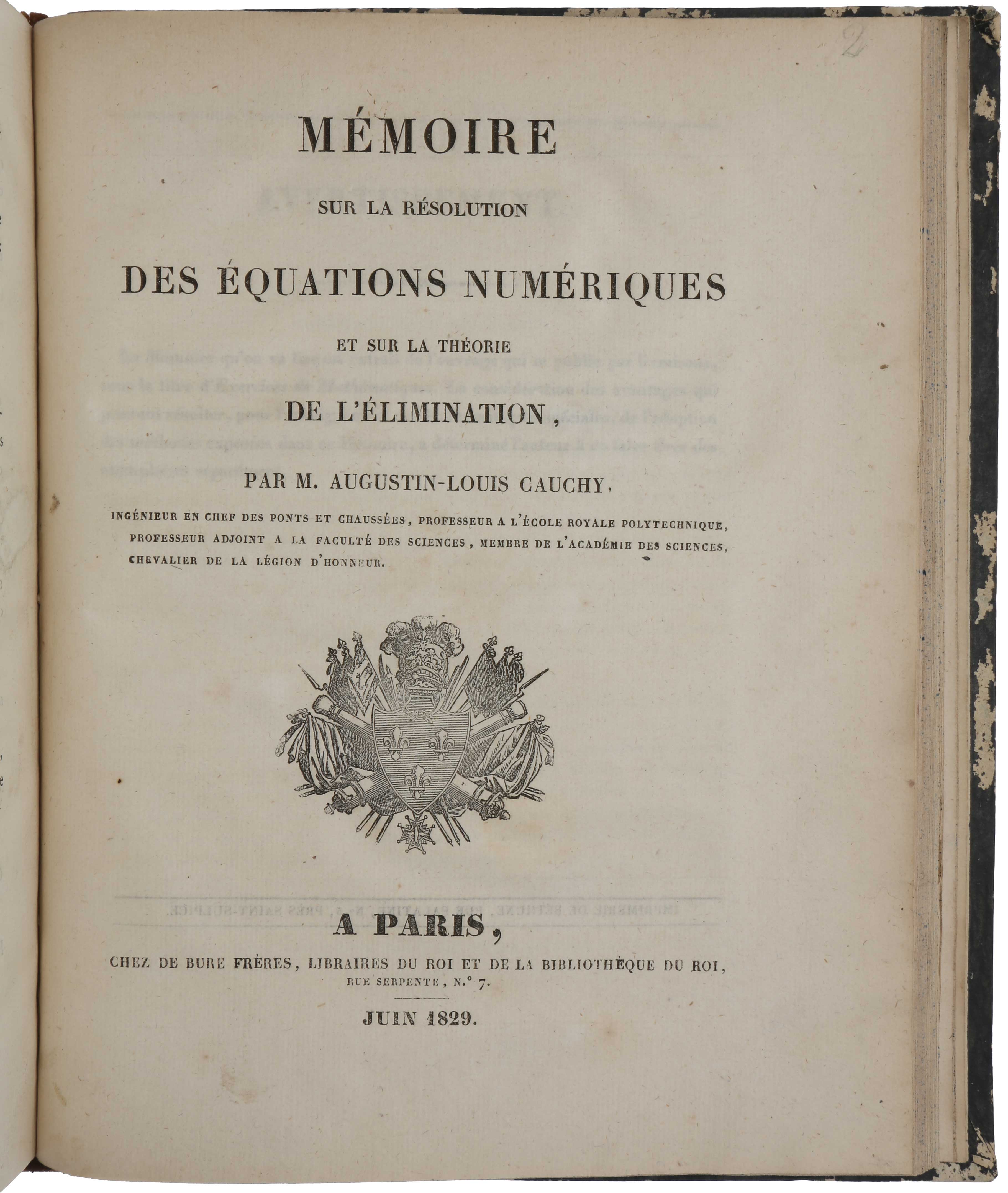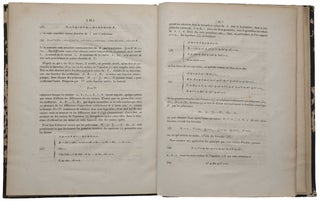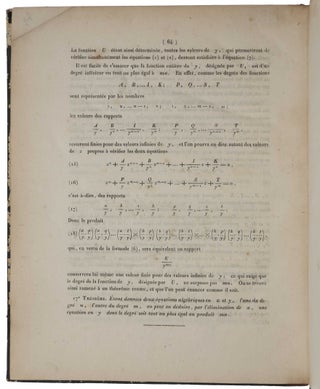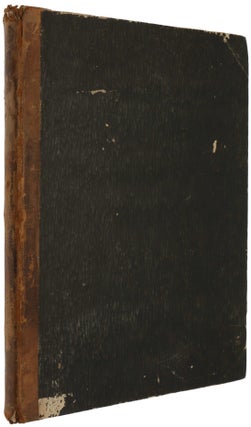Mémoire sur la Résolution des Équations numériques et sur la Théorie de l’Élimination.
Paris: de Bure Frères, 1829. First edition, very rare, of Cauchy’s important memoir on the determination of the real roots of polynomial equations. As stated in the ‘Avertissement’, this is a (separately-paginated) offprint from Cauchy’s Exercises de Mathématiques, Quatrième Année, 1829 (journal pagination 65-128). The problem of determining the real roots of an equation was a famous one with a long history, having been considered by Descartes (who gave an upper bound for the number of real roots in his famous ‘rule of signs’), Newton (who gave an upper bound for the size of any real root), Lagrange and Fourier (who gave upper bounds for the number of roots by considering the sequence of derivatives), and others, but Cauchy was the first to give a complete solution in his paper ‘Memoire sur la Détermination du Nombre des Racines réelles dans les Équations algébriques’, published in 1815. The method was cumbersome and impractical, however, and Cauchy returned to the problem in 1829, giving a more straightforward procedure. The first step in the new method was to find an interval in the real numbers which contains all the real roots of a given equation: this was ‘Cauchy’s bound’. The next step was to show how to divide this interval into a finite number of subintervals each of which contains at most one real root of the equation. By examining the changes of sign of the polynomial at the endpoints of these subintervals, it is easy to determine which subintervals do in fact contain real roots. The roots themselves can then be determined approximately with any required degree of accuracy by a repeated bisection procedure. The second step in the method required a detailed study of the symmetric functions of the roots of a given equation, and as a by-product of this study Cauchy gives in the final section of the paper a simple solution of the problem of eliminating a variable between two given equations, one which had also exercised mathematicians since the 17th century. OCLC lists copies in US at Columbia, Harvard and MIT only. No copies in auction records. We have found no records of an offprint of the 1815 paper. Born in Paris in 1789, Cauchy entered the École Polytechnique in 1805, where he studied engineering. Because of his poor health, he was advised by Lagrange and Laplace to devote himself to mathematics. In the first months of 1813, Cauchy was hoping to gain election to the ‘First Class’ of the Institut. “… a week before the geometry section was to submit its list of candidates, Cauchy presented a new study on the theory of equations to the First Class. Thus he artfully caught the eyes of the members of the Institut. Cauchy expected to give verbally a concise account of the contents of this paper at the First Class' meeting of May 17. But other readings filled up the meeting. In this account, which he published a few days later, Cauchy intended to pay his respects to Lagrange, ‘the great geometer whose passing has saddened learned circles everywhere in Europe as much as it has saddened us’, and he presented his own work as a response to a problem that Lagrange had posed in his Traite de la Resolution des Equations Numeriques de tous les Degres. “Lagrange had published that work in 1798, and in it he examined Descartes’ rule on the number of positive roots of an algebraic equation. This rule had been proved by De Gua in 1748, and Lagrange’s work proceeded to pose – but not solve – the more general problem of the a priori determination of the number of real roots, whether negative or positive, of an equation. While there may no doubt be that Lagrange’s research was the source of Cauchy’s inquiries on the subject, as Cauchy himself declared in his account, it is at best only indirectly so, for it was Poisson who had suggested this research problem to Cauchy. Moreover, nowhere else in the memoir Cauchy published on the subject two years later [the offered extract] is Lagrange mentioned. The homage Cauchy paid to Lagrange thus appears to have been rendered with an eye on the coming election to the seat that Lagrange had left vacant” (Belhoste, Augustin-Louis Cauchy: A Biography, p. 37). Cauchy was unsuccessful in the election. “He was no doubt deeply hurt by these sharp checks on his ambitions, and being only partially recovered from his illnesses, he requested a six-months’ leave of absence without pay to regain his health. This sick leave was granted on June 5, 1813. However, he had to wait until mid-July to be replaced by the engineer Denoël before enjoying his leave. “Cauchy took advantage of this new sick leave to resume his research on the problem of the a priori determination of the nature and number of roots of an algebraic equation. The method he had propounded in May 1813 had, in effect, turned out to be difficult and applicable only to equations with simple roots. Thus, on October 18, 1813, he submitted a new paper to the First Class of the Institut, stating: ‘Two months ago, I had the honor of submitting to the Class a method by which I could determine a priori the real roots of a given equation. The Class decided to honor it with their approval. However, although that method is capable of yielding a solution to the problem when applied to equations of any given degree, one must take account of the number of equal roots and of the multitude of special situations that are prejudicial to the results obtained. The method I propose today does not have these drawbacks. It allows us to determine the number or roots, positive and negative, in a general way and that is independent of any considerations of equal roots and of other special cases that might arise.’ “Cauchy first developed his ideas in geometric terms with no ‘mathematical formulation’, and then proceeded to develop an ‘application to analysis of the preceding discussion’ … Cauchy wrote several supplementary notes, probably during the following months; and, at last, on November 22, 1813, he submitted a new study on this subject to the First Class of the Institut. “Cauchy had now spent many months working on this problem, and although Poisson's report was favorable, the undertaking was only partially successful. To be sure, he had shown for the first time that it is always possible — at least in theory — to determine a priori the nature and number of roots of an algebraic equation. In practice, however, this method led to long, complicated calculations and was accordingly almost unusable” (ibid., pp. 38-9). Cauchy’s long ‘Memoire sur la Détermination du Nombre des Racines réelles dans les Équations algébriques’ contains, as stated at the beginning of the memoir, the substance of the various studies on the real roots of equations Cauchy had submitted to the Institut during 1813. Cauchy returned to the problem of determining the real roots in the 1829 memoir. He began by establishing what has become known as ‘Cauchy’s bound.’ Suppose we have polynomial p(x) = xm + am-1xm-1 + …. + a1x + a0, where the coefficients a0, a1, …., am-1 are real numbers. Let M be the greatest of the positive numbers in the list ±a0, ±a1, …., ±am-1, and let A = M + 1. Then Cauchy proves (p. 29) that all the real roots of the equation p(x) = 0 lie in the interval of real numbers between –A and A. The next step is to find a small positive number Δ such that each of the subintervals –A to –A + Δ, –A + Δ to –A + 2Δ, …., A – Δ to A, contains at most one real root (pp. 58-59). This is the most difficult part of the proof and is based on a detailed analysis of the ‘symmetric’ functions of the roots, i.e. functions of the roots that are unchanged when the roots are permuted in any way. It was well known that any such function of the roots could be expressed as a function of the coefficients of the polynomial. Once this is known it is easy to find which of the subintervals actually contain a root: if the polynomial p has a different sign at the two endpoints of a given subinterval, then that subinterval contains a root; otherwise it does not. This is essentially the ‘intermediate value theorem’ for continuous functions which, rather curiously, Cauchy seems to regard as being self-evident in the present work, although much of his Cours d’Analyse (1821) was devoted to developing a rigorous proof. Once a root has been localized within a subinterval, Cauchy shows, by a method that was then well known, how to determine it to any desired degree of accuracy. The subinterval is divided into two equal parts at the mid-point and one examines the sign of the polynomial p at that point. This tells one which of the two new subintervals contains the root. Iterating this procedure enables one to localise the root to any degree of accuracy. The final section 8 discusses the application to elimination theory. The problem is to find the condition on the coefficients in order for that polynomials xm + am-1xm-1 + …. + a1x + a0 and xn + bn-1xn-1 + …. + b1x + b0 have a root in common (this is the result of ‘eliminating’ x between the two equations). Cauchy introduces the quantity U which is the product of the mn differences between each root of the first polynomial and each root of the second. This is a symmetric function of the roots of each polynomial, and can therefore be expressed in terms of the coefficients of the two polynomials. Cauchy indicates how this is done, thus giving an explicit solution to the elimination problem. As stated in the ‘Avertissement’ on p. [iii], this work is an offprint from Cauchy’s Exercises de Mathématiques. Early in his career as a mathematician, Cauchy found that the volume of his research output could not be accommodated in the Memoirs of the Academy (for example, his great work on complex function theory was written in 1814 but not published in the Institute’s Memoirs until 1827). He therefore started to publish his work in what was essentially his own mathematical periodical, the Exercices de Mathématiques, which appeared yearly starting in 1826. This continued until 1830, when Cauchy exiled himself to Turin following the July Revolution of 1830, which replaced Charles X with the Orléans King Louis-Philippe, to whom Cauchy refused to swear allegiance.
Bound after: ‘Memoire sur la Détermination du Nombre des Racines réelles dans les Équations algébriques; Extrait de plusieurs Mémoires lus à l’Institut, dans le courant de l`année 1813,’ extracted from Journal de l'École polytechnique, XVIIe cahier, t. X, 1815. Two works bound in one volume, 4to (254 x 203 mm), [Résolution:] pp. [iv], 64; [Détermination:] pp. 457-548. Contemporary quarter-calf and speckled boards, some wear and rubbing.
Item #4460
Price: $1,200.00





